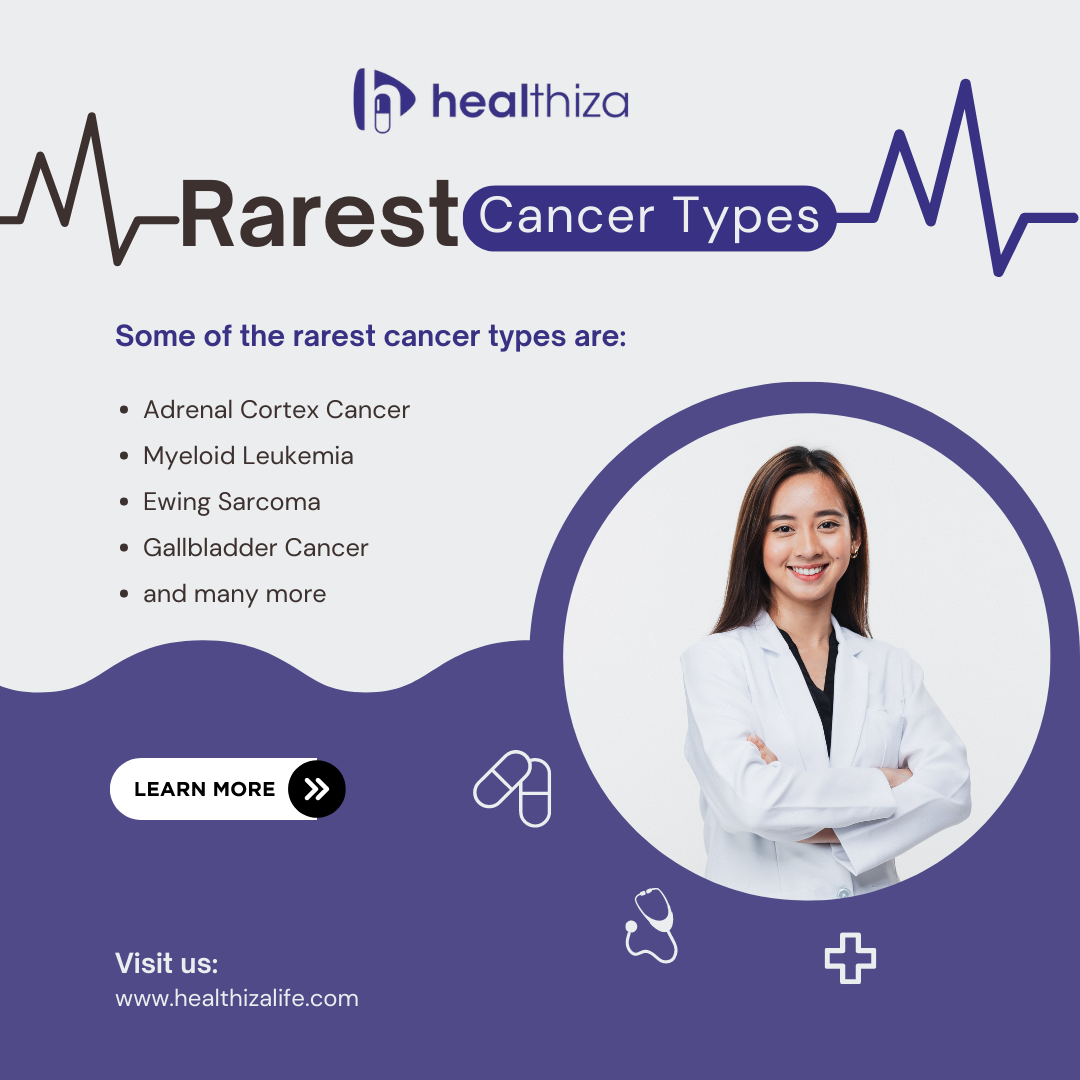Rarest Cancer Types
There are many common and rarest cancer types available. The rarest cancer types—some of which you have probably never heard of—are briefly discussed in this article.
Less than 15 people per 100,000 are annually affected by rare forms of cancer like chronic myeloid leukemia and Ewing sarcoma. There are several risk factors, signs, and predictions for rare tumors, which can affect any portion of the body. However, It is possible to treat with awareness, care, and anticancer medicines.
Some of the more typical cancer forms may be ones you are familiar with. These include colorectal cancer, lung cancer, breast cancer, and prostate cancer.
However, certain cancers are substantially more uncommon.
Adrenal Cortex Cancer
The adrenal gland’s outer layer, which produces hormones like cortisol, is affected by adrenal cortex carcinoma (ACC).
ACC is common among the rarest cancer types, affecting only one person in every million. Males are less likely to experience it than females.
Although ACC can manifest at any moment, it often affects middle-aged adults. An increased risk exists for those who have specific genetic diseases like Li-Fraumeni syndrome and Beckwith-Wiedemann syndrome.
Hormone overproduction is a possibility in ACC tumors. As a result, the signs and symptoms of this malignancy frequently coincide with those of high levels of cortisol hormones like testosterone or estrogen.
The overall survival rate was reported to be 3 to 4 years in research that examined survival rates in 47 individuals with ACC. For patients with progressed or metastatic ACC, the survival rate was cut to 15 months.
Myeloid Leukemia
Myeloid stem cells, which eventually give rise to blood cells like neutrophils, are affected by chronic myeloid leukemia (CML), a kind of leukemia with a slow growth rate.
CML is uncommon despite being one of the four primary kinds of leukemia. According to estimates, 1 in 100,000 persons worldwide will experience it.
Males are more likely to get CML than females, and the risk rises with age. The only additional risk factor that has been identified is prior radiation exposure.
CML symptoms may include:
- Tiredness
- Fever
- Night sweats
- Unintended loss of weight
- Bone pain
- The left side beneath your ribcage may feel heavy due to an enlarged spleen
People with CML had a 70.4% 5-year overall survival rate.
Ewing Sarcoma
The majority of patients with Ewing sarcoma are children and teenagers. It is an aggressive form of bone cancer. It barely affects 1 to 3 people out of every million people each year, despite being the second most frequent form of bone cancer in this age group.
Teenagers are the most common age group for Ewing sarcoma diagnosis. Males also seem to develop this cancer a little more frequently.
Ewing sarcoma symptoms can include discomfort as well as swelling in the vicinity of the tumor. Fatigue, fever, and accidental weight loss are some of the more typical symptoms that might occur.
Eye Cancer
Any form of cancer that develops in the eye is known as eye cancer. The most prevalent type of adult eye cancer is ocular melanoma, which only impacts 5 out of every million people.
A few less frequent eyes tumors are as follows:
- Retinoblastoma
- Medulloepithelioma
- non-Hodgkin’s lymphoma of the eye
The likelihood of developing eye cancer can vary depending on the type of malignancy. For instance, getting older, having a previous history of melanoma, and having lighter skin or eyes are some indications of ocular melanoma.
Typical signs of ocular cancer include the following:
- eye redness
- eye discomfort
- changes in vision
- vision loss
- Dark spot area on your white pupils
The likelihood of survival varies depending on the type of eye cancer.
Gallbladder Cancer
The gallbladder, which houses the bile needed for digestion, is where gallbladder cancer first appears. The following are a few of the recognized warning signs for gallbladder cancer:
- Greater age
- Being a woman
- An inheritance of gallbladder cancer
- Previous gallstones
- Obesity
Gallbladder cancer symptoms can include:
- Abdominal discomfort
- Vomiting and nausea
- Jaundice
- Decreased appetite
- Unintended loss of weight
- A palpable belly bumps
Hairy Cell Leukemia
The immune system’s B cells, which produce antibodies, are impacted by hairy cell leukemia (HCL), a slow-growing form of the disease. In HCL, under a microscope, the afflicted cells resemble “hairy” structures.
Globally, it is thought that 0.3 out of 100,000 men and 0.1 out of 100,000 women are affected with HCL, which is more frequent in men. With age, the likelihood of HCL rises.
Those who have HCL frequently have low blood levels, which can cause anemia, an elevated risk of infection, and simple bleeding or bruising. Additionally, the spleen may grow, causing discomfort and swelling in the abdomen.
90% of HCL patients survive five years without experiencing a complication after receiving treatment. Additionally, several studies have shown that HCL patients can be treated and live a typical life.
Hepatoblastoma
Hepatoblastoma is a form of liver cancer that primarily affects children. Even though it’s the most typical form of liver cancer for people in this age range, it’s still quite uncommon.
Hepatoblastoma symptoms might include:
- An expanding, unpleasant, and uncomfortable abdominal lump
- Abdominal enlargement
- Diminished appetite
- Unintended loss of weight
- Nauseous and dizzy
According to studies, 81.9% of hepatoblastoma patients survive for at least five years.
Kaposi Sarcoma
Kaposi Sarcoma (KS) is a type of cancer that begins in the cells that line your blood arteries. It is brought on by Kaposi sarcoma-associated herpesvirus (KSHV) infection.
The number of people with KSHV is significantly higher than that of KS all over the world. This is so because having HIV, having an organ transplant, becoming older, or having a weaker immune system are the key risk factors for KS.
KS signs and symptoms are:
- Skin diseases, like:
- Most frequently appear on the lower body and face, and can be elevated
- Results in aches and swelling
- Throat or mouth lesions
- Bodily lesions that could bleed or impact how certain organs and tissues function
Lip Cancer
Lip cancer is oral cancer and among the rarest cancer types that begins on the lips. Many people are impacted by it each year.
Risk factors for lip and oral malignancies include:
- Older age
- Cigarette use
- Heavy drinking
- Long-term exposure to ultraviolet (UV)
- Infected with the human papillomavirus (HPV)
Lip cancer patients may exhibit the following signs:
- A lip lesion or sore that won’t go away
- Your lip developing a bump or thickening there
- An area of white on your lip
- Unexplained bleeding, discomfort, or numbness that affects your lips
Retinoblastoma
A form of cancer known as retinoblastoma damages children’s retinas in their eyes. It affects 11 out of every 1 million children under the age of 5 worldwide, making it the most prevalent eye malignancy among kids.
A heritable gene mutation that causes retinoblastoma is the source of the disease. As a result, a child’s risk of developing retinoblastoma is increased if their family has a history of the disease.
Retinoblastoma symptoms can include:
- Uncolored pupil
- Squinted eyes
- Eye color
- Eye discomfort
- Enlarged eye
- Decreased vision
With proper care and cancer medication, more than 90% of kids with retinoblastoma can enter remission—a state in which the tumor is no longer visible and is not anticipated to come back. In reality, studies have shown that retinoblastoma has a 96.3% 5-year survival rate when it affects one eye and a 92.5% 5-year survival rate when it affects both eyes.
Vaginal Cancer
The female reproductive tract’s vagina, which joins the cervix to the exterior of the body, is the site of vaginal cancer, which is cancer that develops there.
Risk elements for vaginal cancer include:
- Old age
- The HPV virus
- A background of cervical, vulvar, or vaginal precancers
- Smoking
- Pharmacologic exposure to diethylstilbestrol (DES)
- HIV/AIDS
Following are a few signs of vaginal cancer:
- Abnormal vaginal bleeding
- Unusual uterine discharge
- Bowel or urinary problems
- Pelvic discomfort
Conclusion for Rarest Cancer Types
Rare cancers come in a wide variety of forms. These malignancies can develop in any area of the human body and have a range of risk factors, signs, symptoms, and prognoses.
In general, early detection and treatment provide the best outcomes for all cancers. If you experience troubling symptoms that are chronic or keep getting worse, it is advised that you speak with a doctor.


